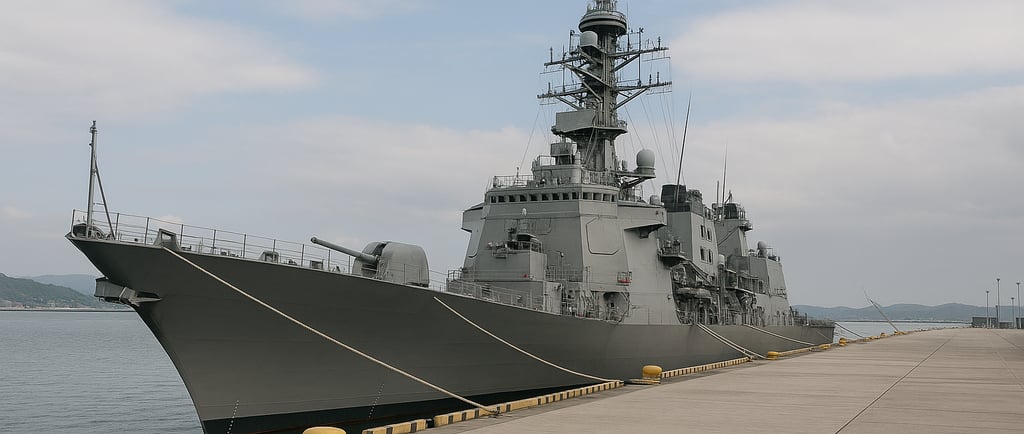The Japanese Navy: between pacifist heritage and geopolitical realities
ASIA
Thomas Dos Remedios
9/1/20254 min read


A RESTRICTIVE BUT EVOLVING PACIFIST HERITAGE
Since 1947, Article 9 of the Japanese Constitution has stipulated that the country ‘renounces war forever’ and ‘shall not maintain land, sea, or air forces’. This legacy stems both from the defeat of 1945 and from the American desire to prevent a resurgence of Japanese militarism. However, as early as 1954, the creation of the Self-Defence Forces (SDF) constituted a first circumvention of this principle: although officially non-military, they nevertheless have capabilities comparable to those of any modern army.
The Japan Maritime Self-Defence Force (JMSDF) was initially built up during the Cold War. The United States, keen to contain the USSR in the Pacific, encouraged Tokyo to develop a fleet focused on anti-submarine warfare and the protection of maritime routes. This allowed Japan to specialise in high-tech areas, particularly missile destroyers and diesel-electric submarines, which are considered among the most advanced in the world.
Internal debates on the interpretation of Article 9 have never ceased. Under Junichiro Koizumi and then, above all, Shinzo Abe, successive governments have expanded the scope of action of the SDF. In 2014, a constitutional reinterpretation authorised the use of collective defence, i.e. the possibility of military intervention alongside allies under attack. This development marks a break with Japan's strictly defensive doctrine and paves the way for a redefinition of the JMSDF as a regional security actor, rather than solely a national protection force.
NAVAL MODERNISATION ACCELERATED BY REGIONAL TENSIONS
The 2000s and 2010s saw a radical transformation of Asia's maritime environment. The rise of the Chinese navy (PLAN), which has become the largest in the world in terms of number of ships (around 370 combat units in 2023, compared to 150 for Japan), is prompting Tokyo to react. Beijing is asserting its ambitions in the South and East China Seas, particularly around the Senkaku/Diaoyu Islands, which are administered by Japan but claimed by China. At the same time, North Korea is stepping up its ballistic missile launches, some of which fly directly over the Japanese archipelago.
Faced with these threats, Japan has embarked on a rapid and targeted modernisation of its navy. The Izumo-class helicopter destroyers Izumo and Kaga are being converted to accommodate F-35B vertical take-off fighters. This decision marks a break with the tradition of not projecting naval air power, long considered too offensive, and transforms these ships into true light aircraft carriers. At the same time, the submarine fleet, comprising 22 units in 2024, including the Sōryū and Taigei classes, is one of the JMSDF's major assets. These submarines are equipped with lithium-ion batteries, which give them greater autonomy and superior stealth compared to conventional models.
Another pillar of modernisation is ballistic missile defence. The Kongō, Atago and Maya class Aegis destroyers are equipped with SM-3 missiles capable of intercepting North Korean projectiles. At the same time, Japan is developing a land-based Aegis Ashore system in cooperation with the United States, although its implementation remains politically controversial. Finally, the strengthening of surveillance in the southern archipelagos, particularly in the Nansei, Miyako and Okinawa islands, reflects the desire to secure areas in the immediate vicinity of Taiwan and Chinese shipping lanes. Radars, drones and new naval bases have been installed there, illustrating the desire to control a highly strategic maritime area.
Compared to China, Japan remains quantitatively inferior, but it compensates for this with qualitative superiority. The JMSDF is renowned for the excellence of its training, its near-total interoperability with the US Navy and its technological lead in specific areas such as submarine propulsion and on-board electronics.
A STRATEGY OF REGIONAL ALLIANCES AND PARTNERSHIPS
Japan's naval rise cannot be understood without considering its network of alliances. The Japan-US alliance, sealed in 1951, remains the cornerstone: Japan is home to nearly 50,000 US soldiers and strategic infrastructure, such as the Yokosuka base, which hosts the US aircraft carrier USS Ronald Reagan. This integration makes Japan a veritable ‘platform’ for the US 7th Fleet in Asia.
But Tokyo is also seeking to diversify its partnerships. With India, it participates in the Malabar exercises, which also bring together the United States and Australia. These manoeuvres symbolise the emergence of the Quad (Quadrilateral Security Dialogue), often presented as an informal coalition intended to contain China.
The JMSDF is also stepping up its cooperation with several ASEAN states. Japan is supplying patrol vessels to the Philippines and developing cooperation in maritime surveillance. It is sharing surveillance technologies with Vietnam and participating in joint exercises. With Indonesia and Malaysia, it is helping to strengthen maritime control capabilities, particularly in strategic straits threatened by piracy.
Finally, Japan is involved in international missions. Since 2009, it has been actively participating in the fight against piracy off the coast of Somalia, and in 2011 it opened a military base in Djibouti. This is Japan's first overseas base since 1945: a powerful symbol that illustrates the transformation of the JMSDF into a force capable of external projection, no longer limited to the surrounding seas.
AMBIGUITIES AND DILEMMAS OF A MARITIME POWER IN THE MAKING
This rise in power remains fraught with contradictions. Internally, Japanese society remains strongly committed to pacifism. Reforms aimed at relaxing or revising Article 9 regularly spark debate and opposition. Governments are therefore moving forward in stages, justifying each reinforcement as a ‘defensive necessity’.
Externally, the modernisation of the JMSDF is viewed with suspicion by Beijing and Pyongyang. China, in particular, accuses Japan of ‘creeping militarisation’ and regularly recalls the traumas of the Sino-Japanese War and colonial occupation. On the other hand, several Southeast Asian countries view Japan as a reassuring partner, capable of counterbalancing Chinese power without arousing the same fears of hegemony.
Japan is therefore caught in a complex equation: it must assert itself as a modern naval power to protect its maritime routes and contribute to regional stability, while respecting the pacifist constraints of its Constitution and domestic public opinion, and avoiding reviving painful memories of its imperial expansion in Asia in the 20th century.
Thomas Dos Remedios, for SPECTIO
The statements made are solely those of their authors and do not reflect the position of the Think Tank Spectio.
